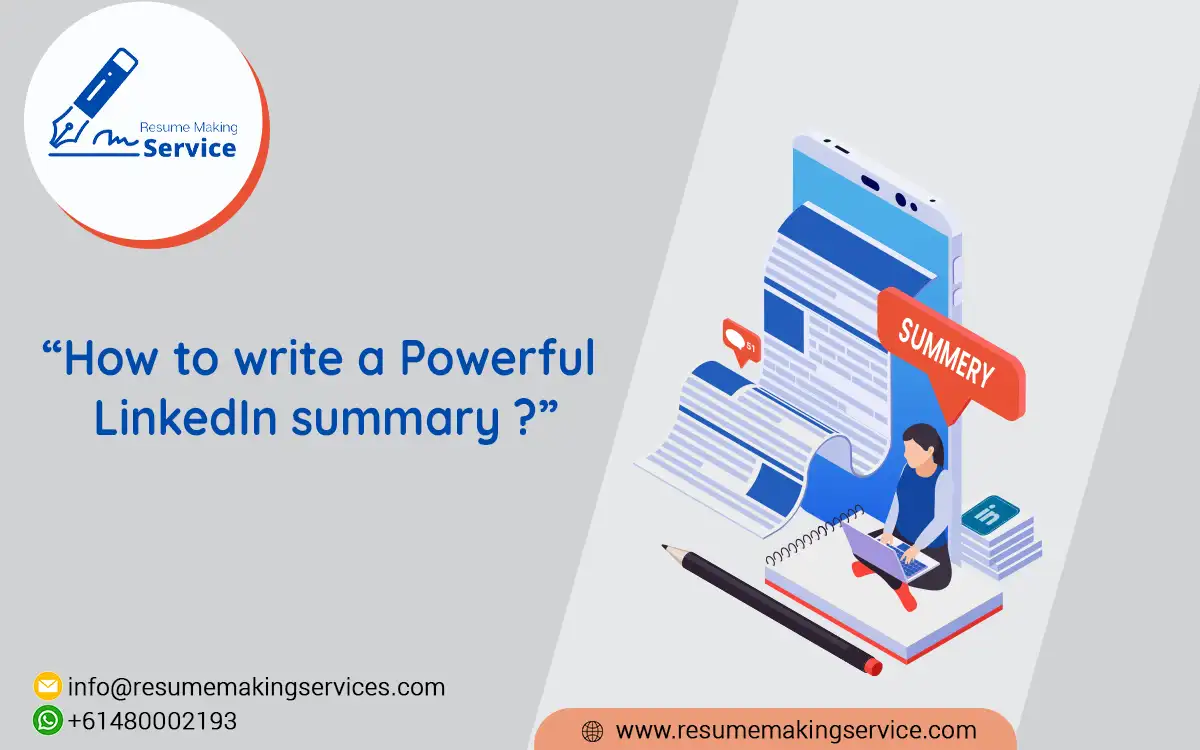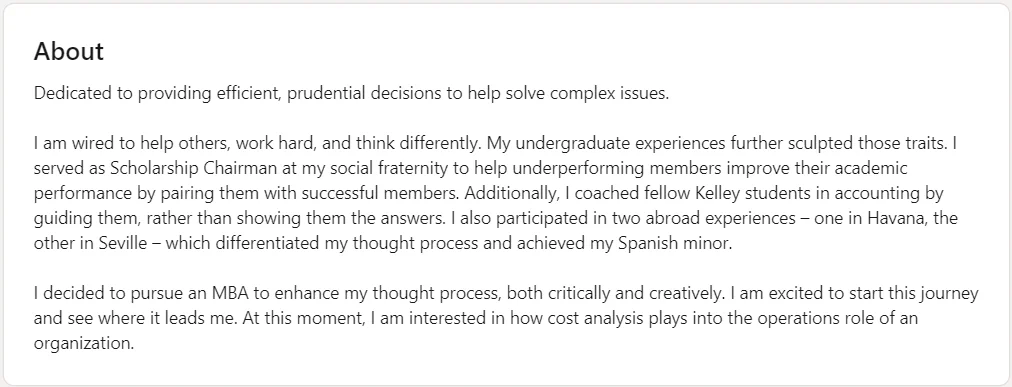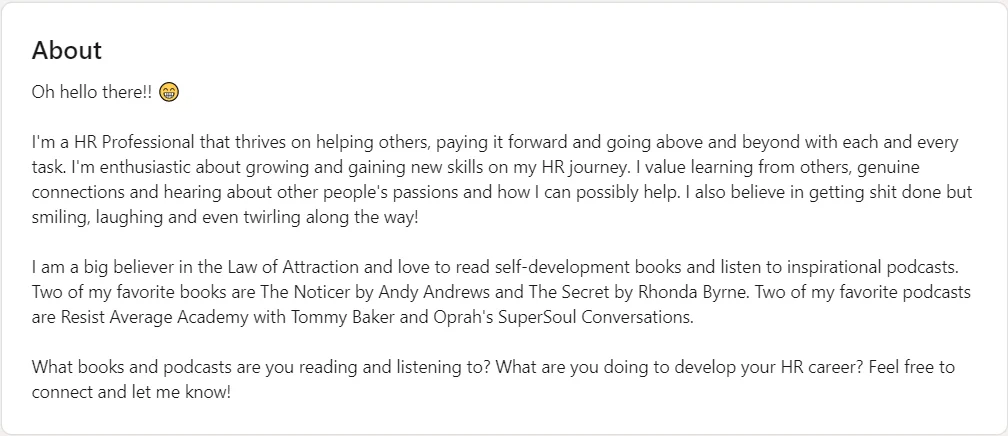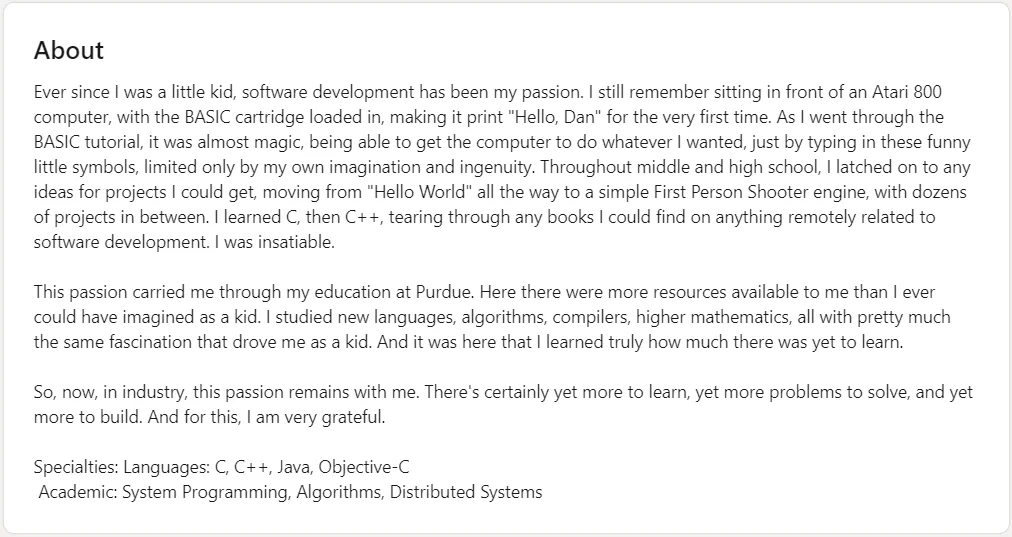
So, what exactly should you include in your LinkedIn summary? Should you simply list out your previous job titles and responsibilities, or highlight your most impressive accomplishments? And what about the tone - can you write it in the first person, or is the third person better suited to the professional context of LinkedIn?
A good LinkedIn summary is essential for your career success. The summary section of your LinkedIn profile should not be overlooked. Why? Because the summary is the first thing visitors read after the headline when they visit your LinkedIn profile.
Many people struggle with this section of their profile, and it's understandable why. So, taking help from services isn't a bad idea. You can create a strong LinkedIn Profile with the help of a professional LinkedIn Profile Writing Service provider.
So, let's get started!
A strong summary can help you stand out and make a positive first impression. The summary section is also important because it allows you to add a little personality and helps you express yourself and tell your story.
Your LinkedIn summary gives visitors a concise overview of your strengths, ambitions, and achievements - just like the objective section of your resume. Your LinkedIn summary, like a good punch line, should be short, straightforward, and powerful enough to capture the reader's attention. The aim is to get them to press the connect button.
Don't just rely on the cookie-cutter bio provided by LinkedIn, as it's important to personalize your summary and make it specific to you and your experiences. Take the time to craft a thoughtful and engaging summary that showcases your strengths and leaves a lasting impression on potential connections.
With a well-crafted LinkedIn summary, you can increase your chances of landing job interviews and making valuable professional connections. Your summary is an opportunity to bring some personality into the content and help frame it.
Your introduction should represent the most important information you want your readers to know more about you. To continue reading, readers must then click "read more”. To make them do that, your summary has to be interesting. So how will you make the visitors want to read more about your summary?
The first sentence of your summary should catch the reader’s attention and convince them to continue reading. To create a strong opening, focus on presenting the most important thing you want readers to know about you. Begin with a personal narrative and a unique value offer. Also, a question that sparks curiosity like what sets you apart from the rest. What skills help you get results? What makes your job so enjoyable for you? What are your most outstanding achievements? Addressing these questions can assist you in developing a powerful opening statement.
The first 300 words of your summary are crucial, so make them fun, exciting, and genuine to hook readers to learn more about you. Also, avoid beginning with a question and using meaningless phrases. If you wish to pack a punk, keep it fun and interesting.
People are more likely to be interested in stories and ideals rather than the basic “what you do” description. So it is better if you include some personal details. Describe your professional journey, what inspires and drives you, and what topics excite you. This way, you’ll be able to interact with people on a more personal level.
Hiring managers and recruiters don’t have time to read a lengthy, difficult essay, so make your summary clear and concise. Eliminate unnecessary information and concentrate on the most crucial details.
Learn what motivated you in your job and what your role's purpose is. These will improve the emotional depth of your LinkedIn profile.
Your summary should create a friendly and approachable tone that engages the reader. It should be conversational, as if you were speaking with a friend, using natural language and no attempt to appear overly official or stiff. It should be simple to read, understand, and relate to, while yet being intriguing and enjoyable.
While writing in a conversational tone, keep your sentences short and sweet. This allows readers to follow along and understand what you're saying. You should also avoid using a complex vocabulary and favor utilizing simple phrases that people are comfortable with.
Another important part of the conversational summary is using humor and storytelling. This helps to capture the reader’s attention and keeps them reading. You can also use comedy to make a point or simply share anecdotes or personal experiences.
Overall, a conversational summary aims to make your information engaging and relatable to your readers. You may develop content that people will love reading and engaging with using accessible tone, short phrases, ordinary language, and even a bit of comedy.
There is nothing wrong with briefly highlighting your professional accomplishments. Highlighting your accomplishment can be an effective way to show your skills and expertise to potential employers. But Don’t just make a list of your accomplishments in the summary. LinkedIn has a separate section for doing so.
Highlight your accomplishments by providing context and details on how you achieved your accomplishments. Remember that your LinkedIn summary should be a great story that tells the story of your professional career. So make it as interesting and entertaining to read as possible! When writing about your achievements, highlight those that are most relevant to the type of career or industry you want.
Taking the time to describe what led to your successes can help readers understand your value beyond the ultimate result. It helps you in building credibility and show yourself as a successful professional in your industry.
Your summary will be boring if you just talk about your work-related information. So, add personal details, work ethic, interests, and sense of humor into the summary. This breaks up boredom and gives readers something to connect with. You could talk about your personality, ideals, and perspective. This gives readers a glimpse into your personality, not just what you do for a job.
Also, use your first sentence to catch the reader's attention. Share a bit about why you do what you do in your introduction. This might be a personal story, a perspective, or even a simple message to the reader. For example: "I love to find new trends on social media. That's what inspired me to work in social media marketing."
Explaining how you first found your passion for your profession, what thrills you about your career, or what you are most proud of may be an excellent method to show your personality and knowledge.
Your LinkedIn profile summary should end with a call to action to encourage engagement from your visitors. You can provide information about your services or how to contact you and emphasize your career goals and achievements. To get maximum response, use the hook, unique selling point, work accomplishments, and call-to-action formula to create a killer profile.
Although listing technical skills can be useful, a call to action can be more effective, especially when looking for new job opportunities. You can share your goals and encourage readers to connect with you on LinkedIn.
To write a compelling call to action, you can use the formula of a hook, unique selling point, and work accomplishments, and encourage readers to message you or schedule an appointment. Strategies for connecting with these issues can help you achieve maximum results from your LinkedIn summary.
Spend some time thinking about your professional background, education, and personal characteristics. And what sets you from others in your line of work? Write down a list of keywords and phrases that describe your strengths and skills.
Imagine you have 30 seconds to introduce yourself to someone in your industry. What would you say? Use your list of strengths and skills to craft a concise, compelling elevator pitch that summarizes who you are and what you have to offer.
Ask a trusted colleague, mentor, or friend to read your summary and provide feedback. Do they feel it accurately represents you and your strengths? Is it engaging and memorable?
Don't simply tell people what you're excellent at; demonstrate it! Use specific examples of projects, achievements, or initiatives you've led that demonstrate your skills and expertise.
You can enhance your summary on LinkedIn by adding multimedia elements, such as videos, photos, and links to your own projects or articles. Use these elements to enhance your message and showcase your work.
Your LinkedIn profile is a dynamic representation of your professional journey, so don't forget to update your summary regularly to reflect your latest accomplishments and goals.
Your LinkedIn summary is an important part of your professional profile. It must portray you positively. To achieve this, it’s best to avoid irrelevant personal information, negative comments about previous employers or colleagues, false information, technical vocabulary, and lengthy paragraphs that could be overwhelming. But instead, aim for a brief and easy-to-read overview that highlights your professional qualities, accomplishments, and goals.
By following these guidelines, you can create an impactful LinkedIn summary that will make you stand out to potential employers and professional connections.

In his LinkedIn summary, Anthony Fioretto explains his academic achievements, career experiences, and hobbies. He has utilized this important LinkedIn area to reflect on his personality, convey his hobbies, and highlight the elements that drive his objectives.
https://www.linkedin.com/in/anthony-fioretto/

Here's an example that shows that an excellent LinkedIn recent graduate student summary doesn't have to be long to be effective. You may influence engagement by concentrating on it and highlighting your talents, which will make you a fantastic addition to any organization or industry.
https://www.linkedin.com/in/megan-mcdonnelltu19/

Genevieve works in human resources. Her profile sticks out from the crowd since it emphasizes her desire to serve others. That gives her profile the appearance of being personable and helpful. She talks about her interests and provides others with a cause to interact with her. Furthermore, her profile invites people to contact her.
https://www.linkedin.com/in/genevieve-mckelly/

Daniel works for Google as a Software Developer. His LinkedIn profile summary is clear and to the point, describing his life path from his boyhood to the present. He clearly mentions his passions and correctly balances industry buzzwords. Although emphasizing his accomplishments, Daniel's biography is far from bragging. In fact, it sounds quite modest!
https://www.linkedin.com/in/daniel-thornburgh-1996a833/

Raphael starts with his previous occupations, which shows you right away that he's (already) had an intriguing career. He then informs you about his present activities.
With its one-line summary of the author's work history, his profile defies expectations and thrills. The range of employment suggests that if he ever comes out of retirement, he can succeed at any workplace. We like how he concludes with his current situation.
https://www.linkedin.com/in/raphael-parker/
Your LinkedIn Profile Summary plays a critical role in attracting potential customers and increasing the likelihood of conversions. Instead of a lengthy and descriptive summary that can bore visitors, it's recommended to write a concise and engaging summary. Adding a call to action, and making it conversational, is also essential to make it easier for visitors to connect with you. Creating a strong LinkedIn summary is just as important as other elements of your profile.